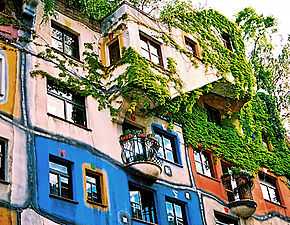Landstraße
| Landstraße | ||
|---|---|---|
| 3rd District of Vienna | ||
| ||
 Location of the district within Vienna | ||
| Country | Austria | |
| City | Vienna | |
| Government | ||
| • District Director | Erich Hohenberger (SPÖ) | |
| • First Deputy | Rudolf Zabrana (SPÖ) | |
| • Second Deputy | Georg Schüller (ÖVP) | |
| • Representation (56 Members) |
SPÖ 23, Green 11, FPÖ 10, ÖVP 9, KPÖ 1 | |
| Area | ||
| • Total | 7.42 km2 (2.86 sq mi) | |
| Population (2014-01-01)[1] | ||
| • Total | 86,454 | |
| • Density | 12,000/km2 (30,000/sq mi) | |
| Postal code | A-1030 | |
| Address of District Office |
Karl-Borromäus-Platz 3 A-1030 Wien | |
| Website |
www.wien.gv.at /bezirke/landstrasse/ | |
Landstraße is the 3rd municipal District of Vienna, Austria (German: 3. Bezirk). It is near the center of Vienna and was established in the 19th century.[2] Landstraße is a heavily populated urban area with many workers and residential homes.[2] It has 86,454 inhabitants in an area of 7.42 km². It has existed since approximately 1200 AD. In 1192, the English King Richard the Lionheart was captured in the Erdberg neighbourhood, after the unsuccessful Third Crusade.
The name Landstraße means "country road". To the tourists, it is mostly known for the 18th-century castle and gardens of Belvedere, the residence of Eugene of Savoy, which today houses the Austrian Gallery. Another residence was built by the Russian envoy to Vienna, Count Razumovsky. A more recent point of interest is the Hundertwasserhaus block of flats (apartment block) designed in a dream-like style by the architect and painter Friedensreich Hundertwasser. Museums in Landstraße include the KunstHausWien (also designed by Hundertwasser) and the Museum of Art Fakes.
Austrian Chancellor Metternich (1773–1859) once remarked, "The Balkans begin at the Rennweg" which was then a mere road in Landstraße, out of Vienna towards the east.
Geography
Landstraße District is located in the southeastern city center of Vienna. It has an area of 7.42 km, or 1.8% of the Vienna City territory. This district is in the middle of Vienna's municipal districts. For one of the "interior districts" the district has a comparatively high proportion of greenery. The district lies along several terraces of the Danube, where the Danube Canal forms the eastern and the Vienna River the northwestern border. In the south of the district, Laaer Berg borders Landstraße.
Sights
 The Hundertwasserhaus. |
Belvedere. |
Notes
- ↑ "Statistik Austria – Bevölkerung zu Jahresbeginn seit 2002 nach Politischen Bezirken", Statistik Austria.
- ↑ 2.0 2.1 Wien.gv.at webpage (see below: References).
References
- [Parts of this article were translated from German Wikipedia.]
- "Wien - 3. Bezirk/Landstrasse", Wien.gv.at, 2008, webpage (15 subpages): Wien.gv.at-landstrasse (in German).
External links
| Wikivoyage has a travel guide for Vienna/Landstraße. |
Coordinates: 48°11′47″N 16°23′45″E / 48.19639°N 16.39583°E
| ||||||||||
| ||||||||

